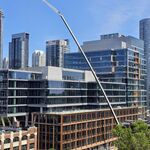Fresh Start
Banned
I dunno, I think your DRL alignment downtown just seems to be connecting dots on a map. A subway like that would never be built today. It's just too all over the place. The curves have to be a lot gentler than that. I think we should choose a road that it'll travel under mostly and stick with it. Or the rail alignment. Or even a big swooping arc up to Pape. e.g. your Queen West and Entertainment stations are at right angles from each other, even though they're one stop apart.
Okay, I'll give this another shot then. I tried to smooth out the curves while not loosing the connectivity of the service. NB- deeper tunnels as I'd use minimize the issue of vibrations affecting residences above a prescribed alignment. It's not only the destinations that I'm focused on but also how the inner-city alignment can intercept several surface transit routes in one sweep. Now instead of Wellington, I chose Front for the brief E-W section through the CBD, such that Queen West and Entertainment Stns can both exist along John proper and afterward the line makes a turning radius down to Union Stn that's appropriate for today's standards (twice the distance of St Andrew-Union). So no loud, screechy turns.

The star attraction of this map however is the Highway 27 BRT, with a special short turn branch during rush hour directly serving Etobicoke North GO Stn and Rexdale Mall via the F.H.C. This in many ways is comparable to a subway (though at a fraction of the expense) due to the ability to sustain an exclusive ROW for most of its length including a long stretch uninterrupted from stop lights between the Queensway and Rexdale Blvd. As the black arrowheads indicate branch services west along Rexdale and Goreway into Westwood Mall; and northbound along Islington into 'downtown' Woodbridge would be possible should demand for direct BRT into these places grows. Lakeshore-Islington-Queensway loop at the southern end would bring mass transit to New Toronto which is gradually experiencing infill development in places the WWLRT or 508 fails to target, particularly along the Queensway.
This combined with BRT through the east-west portion of the F.H.C. does away with the need for a Finch West LRT.
Other fantasy proposal elements include:
- I put both a rail corridor alignment and inner-city alignment for the DRL into the map to allow for a visual compare/contrast; with intercepting surface transit highlighted in red to see which offers the best alleviation. You may argue that the more curvy inner-city route will elongate travel times to the CBD but at least it'll minimize the time wasted on streetcars afterward to backtrack to the downtown's major commercial/job centres outside of the Financial District including Queen West, Cabbagetown, Little Italy, etc.
- I extended the Bloor-Danforth five stops west to terminate in the bustling downtown of Cooksville via East Mall, West Mall, Dixie GO and the Mississauga Chinese Centre (midway in-between Tomken and Cawthra- easy walking distance to either). This is met by a Hurontario LRT "subway" which eventually runs at-grade north of Eglinton.
- New GO stations for the Junction, Kingsway Mills, and of course Mt Dennis. GO service along the Midtown corridor.
- How I'd direct the Eglinton subway into Pearson Int'l airport is very simple. By Martin Grove the subway would either be in a trench or elevated above the streetscape a la Yorkdale Stn. As a hydro corridor conveniently routes perpendicularly up to Hwy 27/Dixon from this point, have the line bridge over Richgrove, Longbourne and Hwy 401; then curve back into the F.H.C. to allow for a east-west station at Hwy 27 (walking distance of Skyway, the Congress Ctr and Doubletree Int'l). Then another stop at Carlingview for all the area hotels which will prove to be a well frequented stop by airport patrons. Alternately Mississauga buses could feed into this stop same as they would @Renforth/Eglinton (# 7, 17, 18, 50). The PIA stop would be at Terminal 1 opposite the people-mover tram, allowing for easy accessibility to points all over the airport. I would even recommend extending the people mover to further stops at Orlando and at Malton GO Stn/International Ctr.
- Oh and kept Jane in, as BRT, but now only from Eglinton northbound via Mt Dennis Stn (no sense placing a subway stop in the middle of Eglinton Flats park for a transfer point, you know).





